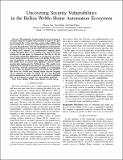Files in this item
Uncovering security vulnerabilities in the Belkin WeMo home automation ecosystem
Item metadata
| dc.contributor.author | Liu, Haoyu | |
| dc.contributor.author | Spink, Tom | |
| dc.contributor.author | Patras, Paul | |
| dc.date.accessioned | 2021-11-11T17:30:12Z | |
| dc.date.available | 2021-11-11T17:30:12Z | |
| dc.date.issued | 2019-06-06 | |
| dc.identifier | 276634349 | |
| dc.identifier | 390b5daa-c03b-4872-bf33-2e225d51f23d | |
| dc.identifier | 85067944614 | |
| dc.identifier.citation | Liu , H , Spink , T & Patras , P 2019 , Uncovering security vulnerabilities in the Belkin WeMo home automation ecosystem . in 2019 IEEE International Conference on Pervasive Computing and Communications Workshops (PerCom Workshops . , 8730685 , Institute of Electrical and Electronics Engineers (IEEE) , pp. 894-899 , SPT-IoT'19 - The Third Workshop on Security, Privacy and Trust in the Internet of Things , Kyoto , Japan , 11/03/19 . https://doi.org/10.1109/PERCOMW.2019.8730685 | en |
| dc.identifier.citation | workshop | en |
| dc.identifier.isbn | 9781538691526 | |
| dc.identifier.isbn | 9781538691519 | |
| dc.identifier.other | RIS: urn:3B16210134F7F91BAEDC79414BC42973 | |
| dc.identifier.other | ORCID: /0000-0002-7662-3146/work/103138178 | |
| dc.identifier.uri | https://hdl.handle.net/10023/24322 | |
| dc.description.abstract | The popularity of smart home devices is growing as consumers begin to recognize their potential to improve the quality of domestic life. At the same time, serious vulnerabilities have been revealed over recent years, which threaten user privacy and can cause financial losses. The lack of appropriate security protections in these devices is thus of increasing concern for the Internet of Things (IoT) industry, yet manufacturers’ ongoing efforts remain superficial. Hence, users continue to be exposed to serious weaknesses. In this paper, we demonstrate that this is also the case of home automation applications, as we uncover a set of previously undocumented security issues in the Belkin WeMo ecosystems. In particular, we first reverse engineer both the mobile app that enables users to control smart appliances and the communication logic implemented by WeMo devices. This enables us to compromise the passphrase guarding the communication over the local wireless network, opening the possibility of eavesdropping on user traffic. We further reveal how an attacker can present a fake device to a WeMo user, through which cross-site scripting can be exploited in order to mislead the user into disclosing private information. Lastly, we provide a set of security guidelines that can be followed to remedy the vulnerabilities identified. | |
| dc.format.extent | 6 | |
| dc.format.extent | 485238 | |
| dc.language.iso | eng | |
| dc.publisher | Institute of Electrical and Electronics Engineers (IEEE) | |
| dc.relation.ispartof | 2019 IEEE International Conference on Pervasive Computing and Communications Workshops (PerCom Workshops | en |
| dc.subject | QA75 Electronic computers. Computer science | en |
| dc.subject | QA76 Computer software | en |
| dc.subject | NDAS | en |
| dc.subject.lcc | QA75 | en |
| dc.subject.lcc | QA76 | en |
| dc.title | Uncovering security vulnerabilities in the Belkin WeMo home automation ecosystem | en |
| dc.type | Conference item | en |
| dc.contributor.institution | University of St Andrews. School of Computer Science | en |
| dc.identifier.doi | 10.1109/PERCOMW.2019.8730685 |
This item appears in the following Collection(s)
Items in the St Andrews Research Repository are protected by copyright, with all rights reserved, unless otherwise indicated.

